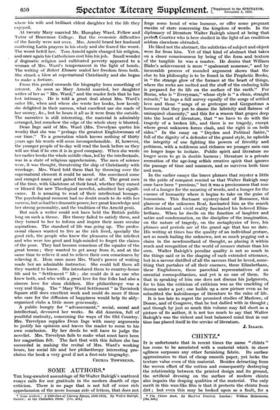CHINTZ.*
IT is unfortunate that in recent times the name " chintz " has come to be associated with a material which in sheer ugliness surpasses any other furnishing fabric. Its surface approximates to that of cheap smooth paper, yet lacks the texture value even of this material. Besides detracting from the woven effect of the cotton and consequently destroying the relationship between the printed design and its ground, the artificial dressing on the surface of modern chintz also impairs the draping qualities of the material. The only merit in this wax-like film is that it protects the chintz from dirt ; but even this may be looked upon as a fault, for a
• The Chintz flask, By lilacIver Percival London: William Heinemann. [iSs. net.]
thorough washing seems to remove the disagreeable surface. As the author clearly shows, early chintz had very little in common with its modern counterpart. A slight surface finish was obtained purely by pressure. It is to be regretted that, because of its title, a number of people, who would otherwise be attracted to this fascinating book, may think that it deals only with chintz as it appears in the modern furnishing store. Mr. MacIver Percival has treated his subject in an entertaining manner, which should appeal to the general public as well as to the collector, and the person who is interested in furnishing his house strictly to period. He has traced the development of the industry historically, technically and even to a certain extent, politically. Yet, unlike most writers on collecting, he is fully alive to the aesthetic appeal of the examples he discnsses, irrespective of their antiquity. His aesthetic judgments are always faultless. Nevertheless, in chintz as in pottery, the earlier designs easily excel the later ones in appropriateness of conception. The factors which contributed to this deterioration in the later examples are many ; but, after an Eastern craft has been introduced to the West, facility in technique almost invariably seems to succeed at the expense of good design. As soon as technical difficulties are overcome by one invention after another, sound workmanship and good design are replaced by the Western idol of speed. The less contact our hands have with the material, the more apparent becomes our lack of feeling for appropriateness of design. In the manufacture of chintz, as again in the potter's craft, it might be said that the deficiency of actual tactile experience has its psychological effect on the producers. It is ridiculous, however, to decry the advent of machinery in industry, or even to go as far as to say that good work cannot be turned out by machinery. Patience is by no means any criterion to go by in art ; economy in the expenditure of energy is perhaps a truer quality and one which is more in keeping with man's biological necessities. Notwithstanding, economy in means must not be confused with economy in effect. That it is more difficult to produce satisfactory patterns when the designer is out of touch with the actual processes of manufacture would be a more correct statement to make concerning the printing of chintz by machinery. The designer of machine-made products must be a potential craftsman who understands that there is no line of demarcation between technique and design.
It would be equally absurd to suggest that the Western manufacturers should have confined their productions to the original Indian patterns, for these, to take the "Tree of Life" pattern as a typical example, have very little appeal to the spirit of the West. They might be termed fatalistic in conception.
Some of the European work, however, reached a very high standard. The example (illustrated on Plate XXVII. (1), which was printed at Nantes in the early nineteenth century, is exquisite, while most of the English work of the same period has the right conception of the form of design best suited to the printed cotton.
An appendix, which consists of the account, by a Jesuit , priest, of the Indian traditional methods of producing fast- coloured decorated cottons, has been added to the book. This should prove of great value to the amateur dyer. It is to be regretted, however, that The Chintz Book is so sparsely illustrated in colour, considering the fact that perhaps the chief appeal of Indian chintz is that of its magnificent purity



























































 Previous page
Previous page